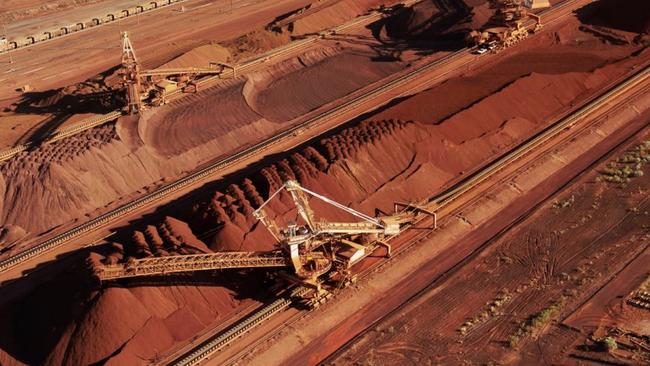Budget 2021: Iron ore price tipped to fall to $US55
Despite a global boom in prices, Treasury officials have taken a far more bearish view on the outlook for iron ore.

Iron ore prices are tipped to fall sharply over the next nine months, according to Canberra forecasts, even as prices for the steelmaking commodity in the past week surged to all-time highs of $US231 a tonne.
Josh Frydenberg’s third budget, delivered on Tuesday, maintains expectations that iron ore will hit its long-term “equilibrium” price of about $US55 a tonne, by the March quarter of 2022 – nine months later than predicted in last year’s budget.
Despite accepting broader analysis that iron ore supply from Brazil is unlikely to recover to previous levels in the near future, and global stimulus measures are likely to drive steel production and therefore demand for iron ore, Treasury officials still took a far more bearish view on the iron ore price than analysts in the private sector.
“Treasury’s industry liaison suggests that in the near term, global iron ore supply is not expected to recover rapidly and the sustained demand for steel production is expected to drive iron ore demand,” the budget documents say.
“The iron ore price is assumed to decline to $US55 per tonne FOB by the end of the March quarter 2022, three quarters later than was assumed in the 2020-21 budget.”
Even through Treasury estimates are based on the price of iron ore as it leaves Australian ports, and do not include the cost of freight built into spot price assumptions, Bloomberg median analyst consensus estimates still suggest the delivered price to China will fall to $US124 a tonne by March 2022 – more than $US50-$US60 a tonne ahead of the bearish Treasury estimates, even assuming elevated freight rates remain in place.
The latest price surge in iron ore price delivered an $8.8bn, or 10.4 per cent, windfall to through company tax receipts compared to estimates prepared ahead of the delivery of last year’s budget in October.
If corporate analysts are correct, rather than treasury officials, the budget’s sensitivity analysis suggests next year’s figures could include another $6.5bn more from company tax revenue than currently predicted.
“There are upside risks to the outlook for commodity prices as industry consultation suggests that iron ore prices could remain elevated for an extended period of time. Meanwhile, a stronger recovery in steel production outside of China could also provide further support for iron ore and metallurgical coal prices,” the budget paper say.
Despite mounting trade tensions, treasury estimate play down the impact of rising trade and political tensions with Australia’s biggest trading partner, saying that Chinese bans on Australian coal and agricultural products have had only a minimal impact on Australia’s recovery from the impact of the pandemic.
“While the ongoing trade restrictions from China have had significant impacts on specific firms and regions, many goods targeted by the restrictions have so far been successfully redirected to other export markets, with limited impacts on Australia’s overall economic recovery,” the documents say.
Prices for Australian thermal and metallurgical coal both tumbled in 2020 in response to China’s bans as Australian producers scrambled to find new customers for their output.
But, despite briefly acknowledging the market volatility caused by tensions with China, treasury tips metallurgical coal prices to remain broadly stable over the nine months, respectively at $US112 a tonne from the port, and $US93 a tonne.
“While Chinese restrictions have affected the price of some types of Australian coal, so far, most coal exports have been able to be redirected to alternative markets. Consultation with market and industry participants, however, has highlighted that there is elevated uncertainty in the coal market, in particular around the duration of the Chinese restrictions on Australian coal, as well as around global environmental policies,” the budget papers say.
And analysts say mounting trade tensions are unlikely to change China’s reliance on Australia to supply its iron ore, as the commodity surged to record highs of $US231 a tonne this week, and Pilbara export volumes hit a 10-month high.
Shipbroker Braemar said Australian producers are on track to ship around 85 million tonnes in May, up 25 per cent on April, and the highest monthly volume since June last year.
Sluggish growth of iron ore production in Brazil has meant that on a global level monthly iron ore volumes are still below 2018’s pace, Braemar analysts said.
Beijing’s bans on Australian coal remain, and LNG has also started to be targeted by smaller Chinese buyers.
But Australia provides 60 per cent of China‘s iron ore and accounts for 70 per cent of Australian exports, with UBS analysts saying this week that China has little near-term alternatives to Australian output.
“Near term, we do not expect the bilateral tension to have a major impact on the iron ore trade as there is no immediate source of iron ore units to replace Australia,” UBS analysts said.
CBA analysts noted that high steel mill margins suggest a fall in iron ore prices is unlikely in the near term.
“China’s National Development and Reform Commission suspended all activities related to the China‑Australia Strategic Economic Dialogue last week, triggering fears that China’s iron ore imports from Australia could be reduced or even banned. We think these are unlikely scenarios given China’s steel sector is heavily dependent on Australia’s iron ore,” CBA said.


To join the conversation, please log in. Don't have an account? Register
Join the conversation, you are commenting as Logout